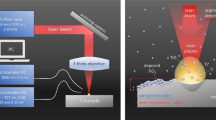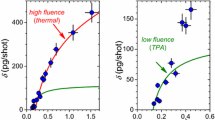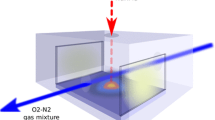Abstract
We have investigated the ablated flux characteristics of PbZrxTi1−xO3 as a function of deposition process parameters. The ablation-deposition rate, angular distribution, and type of ablated species are all affected by the oxygen gas pressure. Visually, a change in the shape and color of the ablation plume are evident upon adding oxygen gas. The ablated flux distribution narrows as the oxygen pressure is increased, from a cos40θ distribution in a low gas pressure, up to a cos260θ distribution at an oxygen pressure of 300 mTorr. This narrowing, or focusing, of the ablated plume also results in an increased deposition rate along the plume centerline for high laser power. However, at low laser power the deposition rate decreases as the pressure is increased, due to gas scattering effects. The energy of depositing species and the ratio of deposition flux to O2 flux will then be very different in each of these two regimes. The species in the plume have been examined using optical emission spectroscopy. We have found that mostly atomic species are present, but the ratio of ions to neutrals is very different for the Pb, Zr, and Ti atoms. Therefore, the application of electric fields near the substrate would affect the film composition to some degree.
Similar content being viewed by others
References
R. Ramesh, W.K. Chan, B. Wilkens, H. Gilchrist, T. Sands, J.M. Tarascón, V.G. Keramides, D.K. Fork, J. Lee, and A. Safari, Appl. Phys. Lett. 61, 1537 (1992).
J.T. Cheung and H. Sankur, CRC Critical Rev. in Sol. State and Mat. Sci., 15(1), 63 (1988).
C.L. Chan and J. Mazumder, J. Appl. Phys. 62, 4579 (1987).
T. Venkatesan, X.D. Wu, A. Inam, and J.B. Wachtman, Appl. Phys. Lett. 52, 1193 (1988).
O. Auciello, S. Athavale, O.E. Hankins, M. Sito, A.F. Schreiner, and N. Biunno, Appl. Phys. Lett. 53, 72 (1988).
D.B. Geohegan, Appl. Phys. Lett. 60, 2732 (1992).
D. Fried, G.P. Reck, T. Kushida, and E.W. Rothe, J. Phys. D: Appl. Phys. 24, 1065 (1991).
J.S. Horwitz, K.S. Grabowski, D.B. Chrisey, and R.E. Leuchtner, Appl. Phys. Lett. 59, 1565 (1991).
R.E. Leuchtner, J.S. Horwitz, and D.B. Chrisey, in Ferroelectric Thin Films II, edited by A.I. Kingon, E.R. Myers, and B. Tuttle, Mater. Res. Soc. Proc. 243, Pittsburgh PA 1992), pp 525–530.
O. Auciello, J. Emerick, J. Duarte, and A. Illingworth, J. Vac. Sci. Technol. A 11, 267 (1993).
Acknowledgments
We would like to thank Craig Near of Morgan Matrock, Inc., for supplying the PZT powder used to fabricate the PZT target. This work was funded by the Defense Advanced Research Projects Agency, grant # 90F131300.
Author information
Authors and Affiliations
Rights and permissions
About this article
Cite this article
Lichtenwalner, D., Auciello, O., Dat, R. et al. Effects of Process Parameters on the Ablated Flux Characteristics During Pulsed-Laser Ablation of Lead Zucconate Titanate (PZT)}. MRS Online Proceedings Library 310, 481–486 (1993). https://doi.org/10.1557/PROC-310-481
Published:
Issue Date:
DOI: https://doi.org/10.1557/PROC-310-481




